

|
Incredible Machines:
Following People Like Us Into the Database Abstract: This site presents a series of investigations around a paper on early computer-generated movies at Bell Labs (and the documentaries that accompany them) through the contemporary cipher presented in the digital compilation movie We Edit Life (2002) by People Like Us (Vicki Bennett).1 A close reading of We Edit Life—tracing its myriad material sources, the mode and style of its composition, the networks of archival dispersion that screen the movie along with presenting its source material, and finally the broader art historical and contemporary cultural context within which the work embeds itself—will offer a passage back into these historical works operating at the birth of computer culture while refreshing their interpretation from our present vantage. The method of this paper, therefore, is waylaid by a heterogeneous array of interpretive and descriptive strategies, applicable to the n-dimensional facets of digital objects in general and the historical conflux of found footage or compilation movies in particular. — Danny Snelson, 2012
|

|
Full Movie: People Like Us, We Edit Life (2002, 10'03") JW Player goes here
|

|

|
|
1. Found Footage and Cultural Critique Before exploring the digital compilation movie, we can outline the methods for interpreting its immediate precursor, the found footage film. Roger Luckhurst, in his excellent article on found footage science fiction films reiterates the received wisdom of collage interpretation: “For the project of found footage… [the] most significant discovery was that the coherence of spliced collages could be held together by the instant recognition of genre iconography and narrative formulae.”2 That the spectator (or critic) may “generate a sort of mega-text of potential narrative possibilities from their implicit familiarity with cinematic codes .”3 And again, “any coherence the film musters is at what [Craig] Baldwin calls the ‘metacinematic’ level, where the spectator can recognize both the codes of each re-purposed fragment but also read the critique.”4 This doxa directs both the creation and the reading of found footage films—subversive montage enacting cultural critique remains the highest form. This holds true for the critic as well as the filmmaker. So pervasive is this interpretive strategy, from avant-garde traditions to television or Hollywood films—to say nothing of the internet—samples from educational, industrial, sci-fi, or ephemeral films are rarely deployed in contemporary works without standing in for some particular object of critique. This generalized demonstration of historical naïveté is then evaluated according to the critical intentions spelled out in the montage of the editor-author. |

|
Full Movie: Bruce Conner, A Movie (1958, 11'40") JW Player goes here
In deference to Conner's well-known response to YouTube, I present A Movie here in absurdly exaggerated compression, thanks to Tudou.com. See also: Caspar Stracke, "The YouTubing of Bruce Conner."
|

|
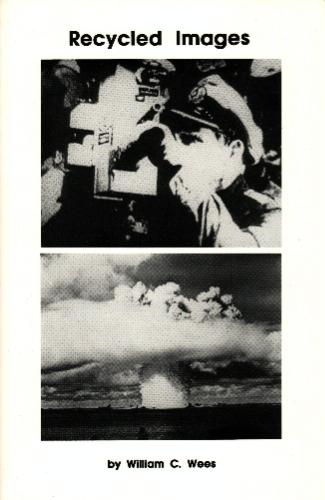 [Wees, Moving in Time, PDF] |

|
Sample Clip: Craig Baldwin, Tribulation 99 (1992, 1'08") JW Player goes here
Via Other Cinema. Similarly, see the hypermediated critical blitz Spectres of the Spectrum.
|

|
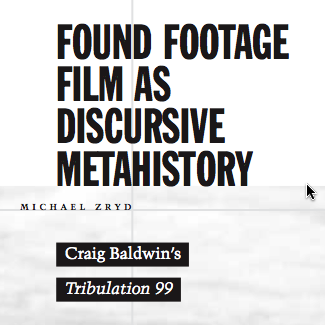 [Zyrd, Found Footage as Discursive Metahistory, PDF] |

|
http://muse.jhu.edu/journals/sff/summary/v001/1.2.luckhurst.html |
|
2. Digital Compilations and Critical Complications However, the model of creation and interpretation built on critique fails digital works on a number of significant levels, high and low. Again, we may say that the critique of institutions holds no water in the free flow of a control society or network culture.5 The practices emerging from the use of filmic artifacts widely available via networked databases operate on dynamic spectra of availability, fluidity, and saturation.6 In particular, the collage essays of People Like Us resist older models of critical interpretation. Over and against critique as a mode of composition, PLU directs our attention to happy accidents, unforeseen rhythms, and regimes of availability—exploring the database as a form rather than critiquing any particular object within that database. Instead these works exemplify the aesthetic turn outlined by Lev Manovich, wherein “pulling elements from databases and libraries becomes the default,” and the joined determinations of software and hardware express the database itself as a dominant form.7 Dense with clips remediated (and hypermediated) from newsreels, industrial films, and popular science footage, these works are structured according to fluid principles of rhythm and digital compositing that erase the specificity of a pointed historical argument.8 Further critical complications arise as each new digital compilation movie activates an index of nostalgic pixels drawn from a variety of analog media. As often as the differences between found footage and digital compilation are noted, filters for reading digital works remain limited by traditional models of critical interpretation. However, viable tactics for reading works crafted within the database can be found within the intricate networks of compilation that form the works themselves. |

|
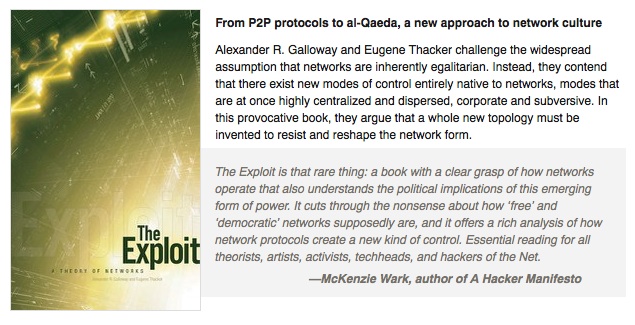
|

|
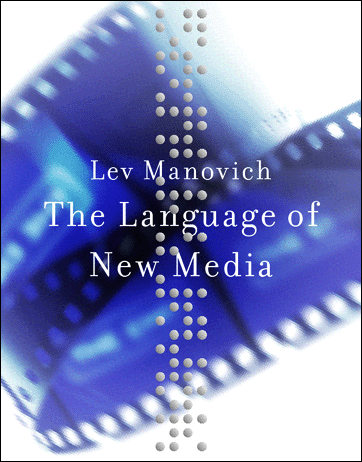
|

|

|
|
3. Actor-Networks and Digital Objects A rigorous accounting coordinated with a remapping of sample-based media manages to highlight the rich conversation (beyond mere genre convention) a new work enacts with—and within—its source material. Additionally, a constructive description offers fidelity to the generative processes of selection, distribution, and editorial modulation at the heart of the work’s networked formation. This is not to discard a political analysis, but to assert that detailed descriptions of the networks of constitutive digital objects more fully inscribes the politics of the work along with a host of empirical data. Indeed, Bruno Latour’s work offers the most powerful corrective to critique, countering the “contradictory repertoires [of] antifetishism, positivism, [and] realism,” marking a critical landscape that’s lost its way.9 Along with Latour’s social history of science, we might argue that for digital movies “there is no greater intellectual crime than to address with the equipment of an older period the challenges of the present one.”10 When everything is available—and previously ephemeral, arcane, or rare footage is only a click away—an appropriate scholarship can only begin by tracing the robust trails of information radiating from any given object. Not only is the character and significance of the contemporary feature shaped by this networked research: the source materials themselves gather relevance in the growing intertext accumulating through each new use and reuse. Thus, rather than performing genre-based cultural critique, this site traces material links extending both inward and outward from We Edit Life, in the attempt to assemble an actor-network for demystification beyond critique. |

|
 [Bruno Latour, "Why has Critique Run Out of Steam? From Matters of Fact to Matters of Concern", PDF]
[Bruno Latour, "Why has Critique Run Out of Steam? From Matters of Fact to Matters of Concern", PDF]
|

|
 [Bruno Latour, Reassembling the Social: An Introduction to Actor-Network-Theory, PDF]
[Bruno Latour, Reassembling the Social: An Introduction to Actor-Network-Theory, PDF]
|

|
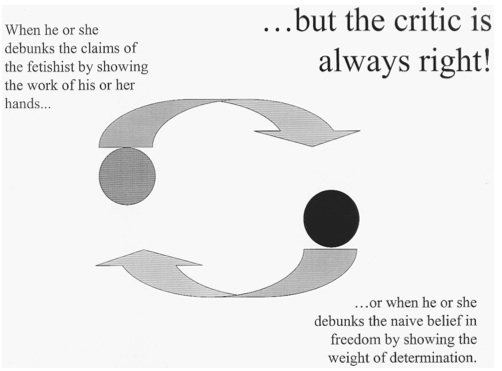 [Bruno Latour, Aramis, or the Love of Technology, PDF]
[Bruno Latour, Aramis, or the Love of Technology, PDF]
|
|
4. Movie Introduction and Online Reception With these tactics now on screen, we can turn our attention to We Edit Life. Commissioned by Lovebytes, We Edit Life debuted as part of an international festival of digital art in Sheffield, UK.11 Reusable from the beginning, People Like Us first presented the digital movie alongside an improvisatory remix performance entitled Recyclopaedia Britannica which resampled many of the sources comprising We Edit Life.12 The first in a series of digital collage works, We Edit Life was soon distributed in a variety of formats on Archive.org, UbuWeb, YouTube, and Vimeo.13 In a statement for the Lovebytes debut of the work, PLU emphasizes the use of samples from the Prelinger Archive.14 Still a nascent project in 2002, the Prelinger Archive joined the Internet Archive in 1999, with substantial uploads of digitized industrial, educational, and ephemeral films only beginning to appear online. More than simply sampling, PLU’s selection of sources for We Edit Life helped generate Prelinger’s digital archive—many required samples had yet to be digitized, and were soon uploaded to Archive.org.15 Thus, in We Edit Life, the viewer sees the creation of the moving picture archive along with an early example of a movie entirely derived from freely available internet content. Three years before YouTube, We Edit Life anticipates widespread flash remix culture—indeed, on YouTube today, DJ Rolling Paper’s remix of We Edit Life outnumbers the original by over 3,500 views.16 The distribution history and reception of We Edit Life can be tracked in comment threads on Comedy Central, via Vicki Bennett’s personal website, and through 63,300 other hits on a Google search for “we edit life” + “people like us.” The reasoning for this brief history of the provenance of the work is not toward comprehension, but dispersion. While it’s obviously impossible to describe this network at large, it would be a greater mistake to begin without a sketch of the scope of its production and distribution. |

|
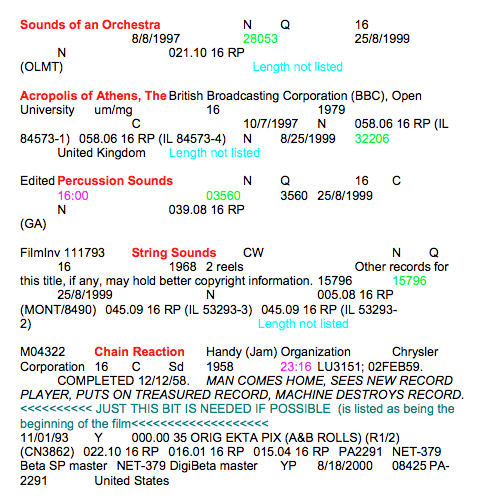 [People Like Us, Selections, PDF] Image pulled from the linked PDF of PLU's 2002 selections from the Prelinger Film Archive, many digitized for We Edit Life, then hosted in full at Archive.org.
[People Like Us, Selections, PDF] Image pulled from the linked PDF of PLU's 2002 selections from the Prelinger Film Archive, many digitized for We Edit Life, then hosted in full at Archive.org.
|

|

|

|
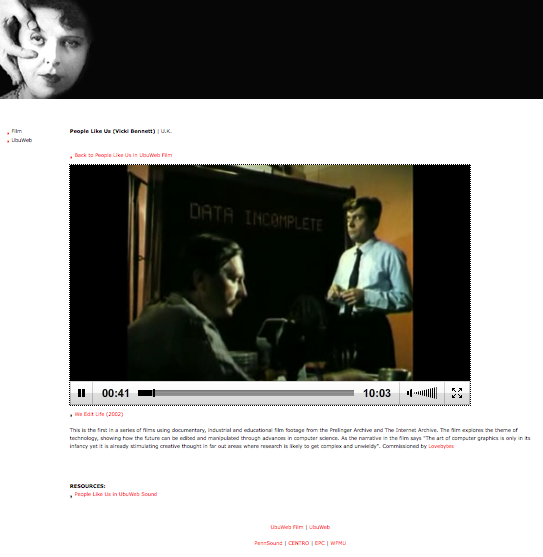
|

|
DJ Rolling Paper Remix of We Edit Life & Crystal Castles "Vanished" 8,697 Views (2.1.12) |

|
Archive.org animated preview GIF for We Edit Life
 http://www.archive.org/details/WeEditLife (enlarged) |
|
5. Opening Frames and Film Leader A pastel colorized leader streams in the browser window, reproducing the grainy filmic attributes of a conspicuously transcoded object.17 The soundtrack, a recording of amplified projector pickups, similarly directs the user to an uncanny moment of filmic projection. We see scratches from the leader’s repeated trips through the projector, along with specks of dust and strands of hair, chemical imperfections in the celluloid, misplaced splices, and frame edges. Though we are viewing in a browser, We Edit Life playfully codes itself as a work of film, confusing the opening moments as the ‘play’ icon of a perfectly animated flash video player fades into the movie. Indeed, while the anachronistic deployment of these cinematic artifacts are common to a computing environment that offers “aged film” filters for nearly every commercial application, the digitized leader and projector soundtrack opening We Edit Life points more strongly to the medial transcoding before the browser.18 Along these lines, we might also productively chart the movements of We Edit Life within a refractive mode of essayistic cinema.19 As William C. Wees outlines in his classic manifesto for Recycled Images, found footage films “cannot avoid calling attention to the ‘mediascape’ from which they come, especially when they also share the media’s formal and rhetorical strategies of montage.”20 While We Edit Life extends far beyond traditional montage, its samples nevertheless consistently index a digital reflection of the filmic mediascape. |

|

|

|
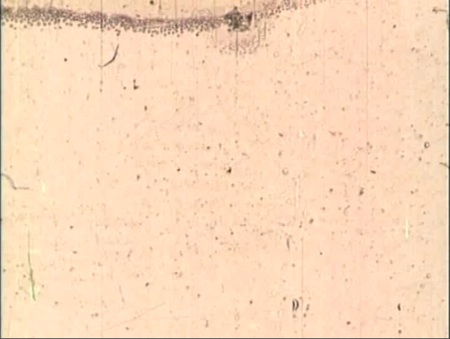
|

|
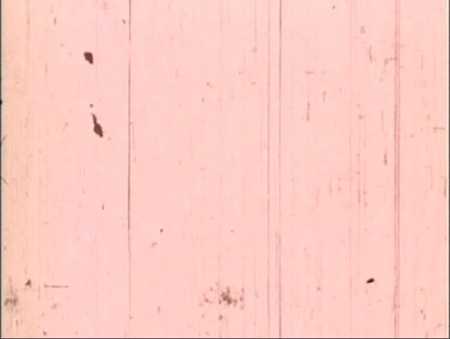
|

|
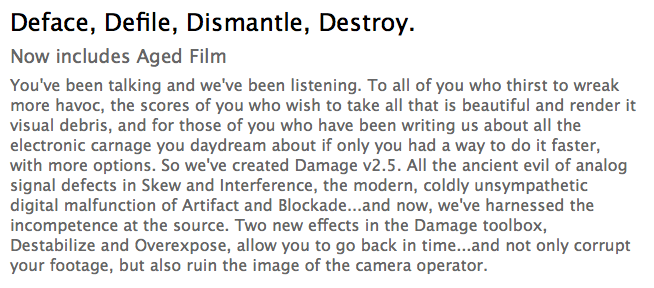
|
|
6. Timing and Synchronization One step further, we may observe how these opening frames draw the filmic source material into a ludic engagement with digital composition. Immediately recognizable to anyone familiar with analog film editing are the puncture holes used for timing and synchronization between film reels. What first registers as a skip or glitch common to film projection still grappling with sprocket alignment reveals itself to be the repeated sequence of frames including the puncture hole. The exactitude of digital repetition is craftily embedded into this archaic representation of leader—the tightly controlled timing of an Adobe editing suite renders imprecise analog techniques inoperative. This digital precision continues into animation as the pastel blue title “We Edit Life” slowly fades in and out over the fluctuating filmic background. As the leader projects an ambient background for the title, these superfluous punctures serve the dual purpose of producing attention to the media historicity of the film as a material object while introducing the seamless techniques of digital editing employed throughout the feature. This database aesthetic returns, as Stephen Mamber has persuasively argued, to a generalized field of analysis more akin to the pre-cinematic work of Marey. Operating as an analytic medium, the digital movie “displaces a dependence upon real-time linear presentation and the chemically-based realism of cinema…in its exposing (even revelling in) its own constructions.”21 |

|
Clip Loop: We Edit Life, Title Sequence (0'0" - 0'5") JW Player goes here
|

|
Konrad Zuse's famous punctured film strip: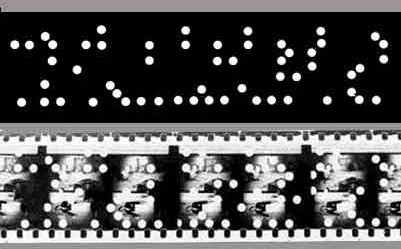
And Manovich on the design for The Language of New Media (pictured above). |

|
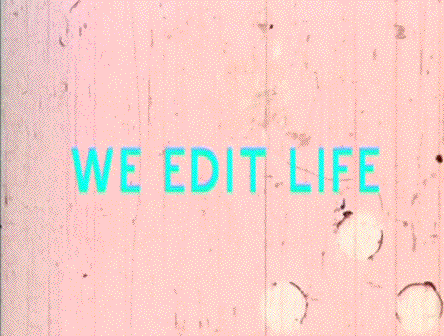
|
|
7. Film Editor and Adobe Premiere Before we lose the attention span of the viewer to another tab, let us quickly skip to the first ‘cut’—a similarly degraded shot of a filmmaker in profile, closely examining a strip of 35mm film. Looking frame-by-frame, with the celluloid in one hand and a pencil in the other, he is both writer and filmmaker—an editor in both senses. Meanwhile, the leader continues to roll out a countdown in a background layer as Bennett keys the film editor up to the first layer in the foreground. Indeed, the meticulous editing of PLU demands a frame-by-frame modulation closer to animation than montage. As we consider the editor with film in hand, we can analyze the composition of this frame of We Edit Life. Toward the end of We Edit Life, we see a mirroring of the film editor’s work desk: PLU’s screen displaying panel arrays of Adobe After Effects 5.0 and Pro Tools Free, both released in 2001.22 The foreground features an After Effects layer trimmed to the editor’s outline while the background continues streaming the leader sample into a count down. More akin to multi-track audio mixing, We Edit Life retains the decidedly DIY aesthetic of digital collage while streaming an increasingly elaborate composite of layered samples throughout the movie. If traditional found footage films require close scrutiny of montage-based juxtapositions, the digital compilation movie requires a detailed accounting of a variety of layered editorial decisions along with the fluid interactions between sampled works. If an understanding of this mode of composition may continue to stream in a background track to this paper, we may begin to explore the samples comprising the layered frame. |

|
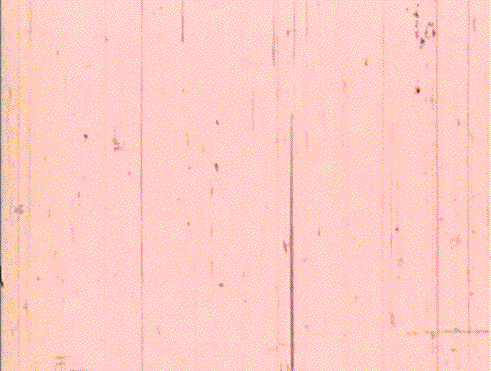
|

|
Adobe After Effects 5.0 with editor's hand (at 6'47"):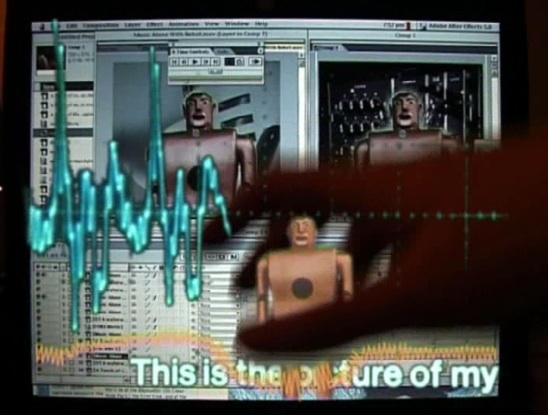
|

|
Pro Tools Free (at 7'00"):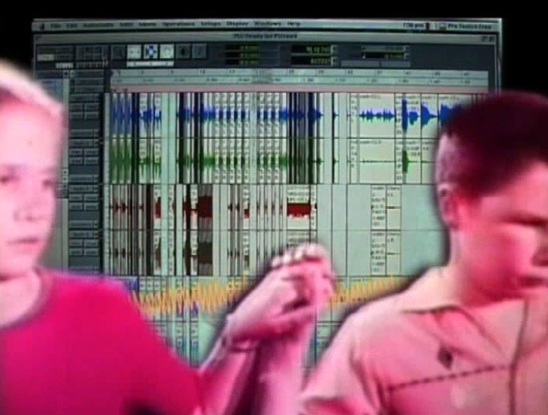
|

|
Adobe Premiere 6.5 splash (2002):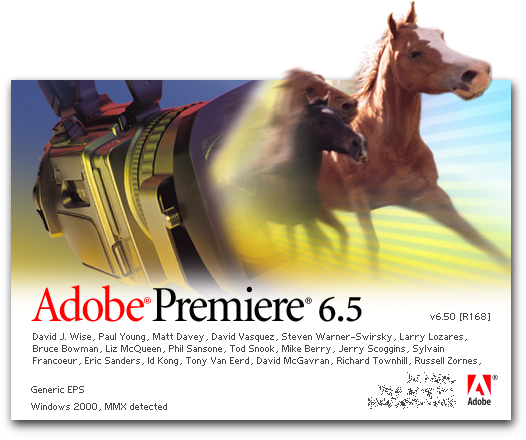 After Muybridge, see also Adobe Premiere Pro.
After Muybridge, see also Adobe Premiere Pro.
|
|
8. Stan VanDerBeek and Kenneth Knowlton “How much trouble is it to get that changed to some other color?” the filmmaker asks, looking up from the celluloid to a technical advisor speaking off-screen. An answer follows: “just find the right place in the program, make the appropriate change, and we’ll run the whole thing again,” but at the mention of the program the filmmaker returns his uncomprehending gaze to the materials at hand. The collaboration at play follows the art-and-technology combination of artist and engineer prevalent in the technological excitement of mid-sixties neo-avant-garde art. The filmmaker shown in profile throughout the scene is Stan VanDerBeek, a prominent underground filmmaker best known for his animated collage films. In 1967, at the time the original footage was shot, VanDerBeek was working as an artist-in-residence at AT&T Bell Labs in Murray Hill, New Jersey. His technical interlocutor is Ken Knowlton, an engineer specializing in computer graphics and motion pictures at Bell Labs. The footage VanDerBeek holds is toward creating one of a series of “poemfields,” a set of experimental short films begun in 1965 that deploy Knowlton’s innovative BEFLIX computer graphics program—a pioneering mode of generating images via a mosaic of Unicode characters.23 Literally, to alter the film, VanDerBeek must inscribe changes to the character mosaic via a card that is fed into an IBM 7094 mainframe that rewrites the entire sequence onto electronic tape that is later fed through a Stromberg-Carlson 4020 microfilm recorder and finally converted to film.24 With characteristic wonder, VanDerBeek notes: “The writing of pictures that will make pictures in motion, in coded text form, means a new notation system to store images by… In other words, motion pictures can be written, stored indefinitely (in punched paper form or tape form) and brought ‘to life’ later. Motion pictures can be conceived (written) in airplanes.”25 Watching VanDerBeek marvel at having Knowlton’s program “run the whole thing again,” we might consider We Edit Life in 2002 alongside the popular emergence of real-time graphic interfaces capable of writing a full range of digital media formats.26 |

|
Clip Loop: We Edit Life, Opening Sequence (0'5" - 0'17") JW Player goes here
|

|
Full Movie: Stan VanDerBeek, Science Friction (1959, 9'51") JW Player goes here
Via UbuWeb Film & Video: Stan VanDerBeek, where the user may find a great digital repository of VanDerBeek's films. Science Friction, VanDerBeek's slapstick collage essay on Cold War technology, science, and politics may offer a provocative formal and thematic analog to We Edit Life.
|

|
 In 2008, Guild & Greyshkul exhibited a Stan VanDerBeek retrospective. While the gallery has since closed, the splash page for the exhibition still hosts an impressive array of PDFs related to VanDerBeek—this site is greatly indebted to their archive.
In 2008, Guild & Greyshkul exhibited a Stan VanDerBeek retrospective. While the gallery has since closed, the splash page for the exhibition still hosts an impressive array of PDFs related to VanDerBeek—this site is greatly indebted to their archive.
|

|
Kenneth Knowlton and Leon Harmon's "Nude" featured in the NYT: [Henry Lieberman, New York Times, October 11, 1967, PDF]
[Henry Lieberman, New York Times, October 11, 1967, PDF]
|

|
IBM 7094: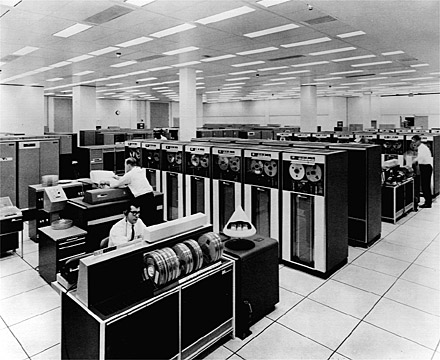
|
|
9. Incredible Machine and Bell Labs Lingering for a moment on this short opening clip, we might return
to the provenance of the sequence featuring VanDerBeek and Knowlton.
The sample is pulled from Incredible Machine (directed by Paul Cohen
for AT&T, 1968), a fifteen-minute sponsored film covering recent
Bell Labs breakthroughs in “computer graphics, computer-synthesized
speech, and computer-generated movies and music.”27 The scene in We Edit Life modifies a sequence entering Incredible Machine at 3:35, rearranging the conversation and
remixing the audio track. Overlays of circuit diagrams and the flashing
text “DATA INCOMPLETE” in the background of this scene in We Edit Life are both sampled from an earlier
segment of Incredible Machine. The chalkboard becomes
another screen, introducing a variety of clips that will feature prominently
in the latter half of the movie—children performing a group experiment
in electricity, flowing graphics representing sound waves, stock footage
of a home, and a layer matrix of hands operating dials. With voiceover
narration and samples from Incredible Machine peppered throughout We Edit Life, the communications research film serves as the
core around which the samples deployed by Bennett constellate and eventually
spin out of control. Even on a cursory viewing, without supplemental
information describing the samples, still, the genre format, ideological
thrust, and intended audience of Incredible Machine are easily recognized
by the casual internet spectator: this is a commercial-industrial- |

|
Full Movie: Paul Cohen/AT&T, Incredible Machine (1968, 14'56") JW Player goes here
Via AT&T Archives, a recent endeavor to distribute a truly incredible set of sponsored films from the Bell Systems archive.
|

|
Movie Clip: We Edit Life, VanDerBeek & Knowlton Sequence (0'17" - 1'10") JW Player goes here
|

|
The extended introduction to We Edit Life thus ends at an impasse. VanDerBeek marvels at the aleatoric character of algorithmic graphical production, while Knowlton insists on the determining nature of the code. PLU heightens this miscommunication as a climactic resolve cued to an electronic score leaves VanDerBeek ambiguously staring, speechless at the boldly determinist assertion of control made by the programmer. At the crux of this misunderstanding, and indeed We Edit Life, are these very questions of creation and control in computational production. |

|
Sampled Clip: Incredible Machine, VanDerBeek & Knowlton Sequence (3'35" - 6'35") JW Player goes here
|
|
10. "Daisy Bell" and Elektro the Westinghouse Robot Continuing this track, our attention to the details of source materials like Incredible Machine opens robust networks of signification in the rhythmic composition of We Edit Life. The structural and semantic importance of Incredible Machine grows increasingly telling as We Edit Life moves from a focus on computer generated film to computer generated music. The score for Incredible Machine, as the narrator reveals, “was entirely composed by a computer.” This would be no small feat just a few years after “Daisy Bell” famously debuted at Murray Hill. The team programming this first computer to sing—comprised of John Kelly, Carol Lockbaum, and Max Mathews—are all featured in Incredible Machine. Mathews, the grandfather of electronic music, provides the score for the film. Sampling Mathews’ pioneering audio track along with visual layers from Incredible Machine, PLU’s aural attention might best locate We Edit Life in a digital music video genre, where both image and sound are driven more by rhythm and fluid spatial montage than cutting. If there is a narrative to draw out from the movie, we might argue for a story of artificial life, as the various dials and diagrams, engineers and conductors orchestrate the creation of a singing robot. Here, Elektro the Westinghouse Moto-Man, sampled from a newsreel of the 1939 world’s fair in New York, may stand in for the titular ‘life’ edited by PLU’s computer.28 As We Edit Life becomes increasingly disjointed toward the conclusion, Elektro joins with a circuit made of children to sing an ominous remix of “Music Alone Shall Live.” Far from generically sampled, the source material behind Elektro’s threatening ballad in We Edit Life invokes a dense mesh of insightful references, beginning with HAL’s death rattle rendition of “Daisy Bell” in Stanley Kubrick’s 2001: A Space Odyssey (1969), which naturally brings us back to Murray Hill and the birth of synthesized speech, covered in detail by Incredible Machine. The ambivalent temporality of We Edit Life imports the technological thrill of these sixties innovations into a premonitory mix with the melodic anxieties of a database that will, as Elektro tells us, outlive us all. |

|
Sampled Clip: Medicus collection, Elektro the Westinghouse Moto-Man (1939, 0'56", silent) JW Player goes here
See full movie via Archive.org.
|

|
Movie Clip: We Edit Life, Singing Robot Sequence (6'07" - 8'29") JW Player goes here
|

|
"Daisey Bell," performed by the IBM 7094: Via YouTube user SlavenovMaliVideoArhiv™. See also, HAL9000's rendition. |

|
Movie Clip: Stanley Kubrick, 2001: A Space Odyssey, HAL9000 Sings Daisy Bell (1'15") JW Player goes here
|
|
11. Poemfield No. 2 and Man and His World Reeling back from this expanding intertext, we might go deeper into the diegesis, returning to the footage VanDerBeek holds at the opening of We Edit Life. The footage under consideration is most likely Poemfield No. 2 (ca. 1966), one of the ten short poetic films VanDerBeek and Knowlton made in collaboration over a four-year span from 1965 to 1969. It might also be Man and His World (1967), a one minute short film after the title for Expo ’67 that translates the phrase ‘man and his world’ into a variety of the world’s languages.29 Literally comprised of a mosaic of international textual detritus and small symbolic characters, the poemfields explore the representational capacities and inherent variability of language within computational environments. While VanDerBeek’s background is in image-based collage films like Science Friction, the lexical construction of BEFLIX films inspired a literary form—each word-image necessarily contains thousands of letters as pixels. Reading the text for Poemfield No. 2 alongside We Edit Life, certain resonant themes emerge: LIFE / LIFE LIKE / POEMFIELD NO. 2 / SIMILAR / LIKE / TO / CLOCK / TICK / WE PICK / LIFE / OUT / OR APART / SEEMING / TO SEE / SEPARATE / THINGS / TOGETHER / SO / YOU / SAY / IT / WOULD / SEEM / LIFE .. LIKE ... / THIS / LIVING / BUT... / WE / ALWAYS / SUSPECT / .. IT … / THE END30 Seeming to see separate things together, PLU reanimates Elektro to a singing life-likeness and more generally deploys disparate archival sources in a variety of repurposed narrative configurations. On this digital translation, we might say We Edit Life, alongside the poemfields, “passes as a punctualized actor,” concealing an intricate network that holds them together.31 The suspicious ease of a cohesive collage is central both to VanDerBeek’s previous films and PLU’s audio remixes, where dead media is everywhere lifelike. Toward these ends, We Edit Life channels the Incredible Machine soundtrack over a man whittling miniature wooden deer over footage of ‘real live’ deer, stating: “Experimenters in visual perception are using computers to create weird, random patterns that never occur in real life...The art of computer graphics is only in its infancy yet it is already stimulating creative thought in far out areas where research is likely to get complex and unwieldy.” |

|

|

|
Full Movie: Stan VanDerBeek & Ken Knowlton, Poemfield No. 2 (5'43") JW Player goes here
|

|
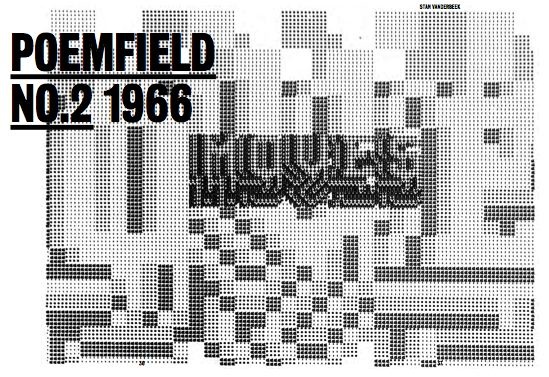 Via Guild & Greyshkul's expansive VanBerBeek archive online.
Via Guild & Greyshkul's expansive VanBerBeek archive online.[Poemfields Collection, PDF] [Poemfield No. 2 Collection, PDF] |

|
Movie Clip: We Edit Life, Deer Sequence (5'43") JW Player goes here
|
|
12. Gathering Sources and Concluding Links While this extended descriptive performance draws out signification
patterns from Incredible Machine and associated materials,
we can conclude by anthologizing a number of the films sampled by PLU, all
of which might offer interpretive feedback between We Edit Life and the database from which
it stems. Rather than bind We Edit Life with an interpretive knot, this site seeks to use the movie as a conduit to open productive passages into the database. Thus, what follows are a select few strands among the many worth tracing: |

|
Home Movie: Browsing the Source Materials & Associated Clips Sequence (8'59") JW Player goes here
|
|
1 For this work, and many others, the prolific audio and video remix artist Vicki Bennett operates under the moniker People Like Us. With respect to this recoded authorship, this paper will refer to the maker of We Edit Life as PLU throughout. 2 Roger Luckhurst, “Found-footage science fiction: five films by Craig Baldwin, Jonathan Weiss, Werner Herzog and Patrick Keiller,” Science Fiction Film and Television 1.2 (2008): 195. 5 See Alexander R. Galloway, Protocol: How Control Exists After Decentralization, (Cambridge, Mass: MIT Press, 2004). 6 Online, visual communication is common and the practice of movie-making de-specialized. Indeed, this argument may be extended to amateur FanVids, digital moving-image essays, and a wealth of emergent motion-picture communication systems enabled by the ease of editing and dispersion across networks. We may also recall that found footage is itself an outmoded term, as footage is replaced by flash, QuickTime, and AVI files. 7 Lev Manovich, The Language of New Media (Cambridge, Mass: MIT Press, 2002), 130. 8 See J.D. Bolter and Richard Grusin, Remediation: Understanding New Media (Cambridge, Mass: MIT Press, 1999). 9 Bruno Latour, “Why Has Critique Run Out of Steam? From Matters of Fact to Matters of Concern,” Critical Inquiry 30.2 (2004): 241. 10
Latour, “Why Has Critique Run Out,” 231. The language of this paragraph
and much of the paper follows on this article and related publications,
see: Reassembling the Social: An Introduction to Actor-Network-Theory
(Oxford: Oxford University Press, 2005); Aramis, or the Love of Technology (Cambridge, Mass: Harvard
University Press, 1996); and the excellent actor-network website, Paris: Invisible City, www.bruno-latour.fr/virtual/ 11
“Lovebytes2002,” http://www.lovebytes.org.uk/ 12
“Lovebytes2002,” http://www.lovebytes.org.uk/ 13 We Edit
Life was first uploaded to The Prelinger Archive (archive.org)
in 2004: http://www.archive.org/ 14
See “Vicki Bennett at Lovebytes 2002,” http://www.youtube.com/watch? 15 Private correspondence with Vicki Bennett, 2011. 16
The remixed We Edit Life is set to a remixed audio track derived from the
Crystal Castles’ “Vanished,” http://www.youtube.com/watch? 17 This paper operates on Lev Manovich’s definition of trancoding to best describe the translation between media formats, and the computerization of culture more generally. See: Manovich, The Language of New Media, 46-47. 18
In the “Trivia” section of Wikipedia’s page on film leader, we can
note the particular resonance of this opening with PLU’s software:
“The video editing software Adobe Premiere (as well as later versions,
including Adobe Premiere Pro and Adobe Premiere Elements) features a
computer-generated version of the SMPTE leader, entitled the "Adobe
Universal Leader." It can be customized with different colors,
and can be set to beep either at the beginning of each number or just
at the two.” http://en.wikipedia.org/wiki/ 19 On refractive essay films, Timothy Corrigan writes: "In these reenactments of the cinematic, the best of these films about art and film do not simply describe or document filmic or other aesthetic practices but specifically engage them within an essayistic arena that abstracts the very activity of thinking through a cinematic process." Timothy Corrigan, The Essay Film: From Montainge, After Marker (New York: Oxford University Press, 2011), 182. 20 William C. Wees, Recycled Images: The Art and Politics of Found Footage Films (New York City: Anthology Film Archives, 1993), 25. 21 Stephen Mamber, “Marey, the Analytic, and the Digital,” Allegories of Communication: Intermedial Concerns from Cinema to the Digital, ed. John Fullerton and Jan Olsson (Rome, Italy: J. Libbey Pub, 2004), 88. 22 Since Marey has just been evoked to highlight the analytic slant of digital movies, let us now note that until 2006 Adobe Premiere software packaging featured an iconic galloping horse in homage to Muybridge. 23 This method of computer graphics was pioneered by Leon Harmon and Kenneth Knowlton in 1967 when his proto-ASCII Seurat-styled “Nude,” sometimes titled “Studies in Perception I” made headlines in the New York Times. See Henry Lieberman, “Art and Science Proclaim Alliance in Avant-Garde Loft,” New York Times, October 11, 1967, p. 49. For a fuller reflection on the project see Kenneth C. Knowlton, “Portrait of the Artist as a Young Scientist,” YLEM 25 (2005): 8-11. 24 Technical details can be found in Knowlton, “Computer-Produced Movies,” Science 150 (1965): 1116-1120; Knowlton, “Computer-Generated Movies, Designs and Diagrams,” Design Quarterly 66/67 (1966): 58-63; and Stan VanDerBeek, "New Talent-The Computer," Art in America 58 (1970): 86-91. 25 Stan VanDerBeek, “Re: Look: Computerized Graphics ‘Light Brings Us News of the Universe,’” Film Culture 48-49 (1970). 26 Adobe Premiere 6.5, released in August 2002, was the first consumer suite to feature real-time previews. 27 Rick Prelinger, The Field Guide to Sponsored Films (National Film Preservation Foundation: San Francisco, 2006), 48. 28
Listed as “Amateur film: Medicus collection: New York World's Fair,
1939-40] (Reel 3) (Part I) (1939)” on Archvie.org: http://www.archive.org/ 29 However, since Man and His World is featured as complete and colorized later on in Incredible Machine, it is unlikely to be the source of the conversation between VanDerBeek and Knowlton during the filming of Incredible Machine. Similar in form, it could be any of several poemfields made around this time. 30 This transcription varies from VanDerBeek’s own notation in an attempt to highlight certain textual features from the film that are elided in the script. 31 John Law, “Notes on the Theory of the Actor-Network: Ordering, Strategy and Heterogeneity,” Centre for Science Studies, Lancaster University (2003), 2. “This, then, is the core of the actor-network approach: a concern with how actors and organisations mobilise, juxtapose and hold together the bits and pieces out of which they are composed; how they are sometimes able to prevent those bits and pieces from following their own inclinations and making off; and how they manage, as a result, to conceal for a time the process of translation itself and so turn a network from a heterogeneous set of bits and pieces each with its own inclinations, into something that passes as a punctualised actor.” http://www.lancs.ac.uk/fass/sociology/papers/law-notes-on-ant.pdf 32 All films not linked in this paragraph have either never been uploaded to the internet, or have been taken down (or perhaps cannot be found by the writer). All are mentioned in PLU's source list, and thus can be presumed present in We Edit Life. |